|
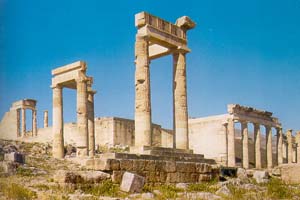
GEOGRAPHY: Cross-roads of civilizations, with an age-old
history and astonishing natural
beauty, Rhodes is the largest island in the Dodecanese
and the fourth largest island in
Greece. It lies at the northeast limit of the Aegean, is
1398 sq. km. in area, has 220 km.
of coastline and a population of 87,831. There is a
regular car and passenger ferry from
Piraeus, 260 nautical miles away, connecting the island
with the rest of the Dodecanese,
Crete and the Cyclades. Local boats also link it with
all the islands of the Dodecanese and
Samos. During the summer hydrofoils make trips to Kos,
Symi, Patmos, Leros, Chalki, Nisyros
and Telos. Excursion craft also operate in the summer
sailing to Kos, Symi and Chalki.
 The
boat plying the Piraeus-Kavala route to the outlying
islands links Rhodes once a week with
Melos, Pholegandros, Anaphi, Santorini, the islands of
the north and east Aegean, Crete and
Kavala. Throughout the year there is a weekly ship to Limmasol in Cyprus and Haifa in
Israel. There are frequent flights from Athens and
regular ones to Kasos, Leros, Carpathos,
Kos, Crete and Mykonos. Last but not least, Rhodes is a
port of call for numerous cruise
liners. The island's main town and harbor is Rhodes,
focus of the extensive network of
roads leading to its many towns and villages. Three
mountainous massifs dominate the island
(highest peak Atavyros, 1215 m. a.s.l.), separated by
fertile valleys and plains with lush
vegetation, woodland and running water in plenty
everywhere, excepting the south of Rhodes
and the area around mount Atavyros. A mild climate,
unique and varied landscape, wonderful
sea, monuments of all periods and antiquities; Rhodes is
a mosaic of all these elements and
its beauty defies description. An international tourist
center with sophisticated ambience,
Rhodes is ideal for holidays all year round. The
boat plying the Piraeus-Kavala route to the outlying
islands links Rhodes once a week with
Melos, Pholegandros, Anaphi, Santorini, the islands of
the north and east Aegean, Crete and
Kavala. Throughout the year there is a weekly ship to Limmasol in Cyprus and Haifa in
Israel. There are frequent flights from Athens and
regular ones to Kasos, Leros, Carpathos,
Kos, Crete and Mykonos. Last but not least, Rhodes is a
port of call for numerous cruise
liners. The island's main town and harbor is Rhodes,
focus of the extensive network of
roads leading to its many towns and villages. Three
mountainous massifs dominate the island
(highest peak Atavyros, 1215 m. a.s.l.), separated by
fertile valleys and plains with lush
vegetation, woodland and running water in plenty
everywhere, excepting the south of Rhodes
and the area around mount Atavyros. A mild climate,
unique and varied landscape, wonderful
sea, monuments of all periods and antiquities; Rhodes is
a mosaic of all these elements and
its beauty defies description. An international tourist
center with sophisticated ambience,
Rhodes is ideal for holidays all year round.
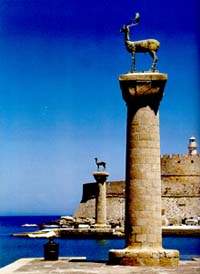 HISTORY: The island's geographical position, between
Occident and Orient, was the major
determinant factor throughout its history. Fruit of the
union of Helios and the nymph
Rhoda, according to myth, Rhodes was first inhabited in
Neolithic times. During the Late
Bronze Age (1550 - 1100 BC) Minoans settled there (lalysos)
and were succeeded in around
1400 BC by Achaeans who established installations over
it. The Dorians arrived here in
about 11 BC, founding three important cities, Lind
lalysos and Kameiros. In 700 BC these
joined the Dorian hexapolis, along with Cnidus,
Halicarnassus and Kos. Thenceforth Rhodes’
power was in the ascendancy and it soon dominated the
whole of the Dodecanese. T economic,
cultural, and artistic zenith was sustained throughout
the 5th, 4th and 3rd cent BC. During
the Persian Wars, Rhodes found under duress alongside
the Persians buts subsequently joined
the Athenian League BC). In 411 BC the three cities
united and 408 BC founded the city of
Rhodes by common consensus. Situated in the north of
island, on the coast, it was laid out
in accordance with plans made by the architect Hippodamos from Miletus on exactly the same
site as the modern city. Rhodes enjoyed exceptional
splendor throughout the 3rd century BC
and dominated the Aegean. Its age had a wide circulation
and this commercial and economic
apogee was accompanied by fervent cultural and artistic
activity. Despite natural disasters
and enemy incursions, which beset Rhodes following the
Roman conquest, it never lost its
pre-eminence and continue be a major naval and
mercantile center. Byzantine era was one of
decline until 1309 when Rhodes was sold to the Knights
of John, which heralded a new floruit. It was this time that the imposing medieval
town built, with its magnificent
buildings and enormous castle. Rhodes was captured by
Turks in 1522 and they remained until
1912 when it passed to the Italians. In 1948 it came
part of the Greek state. HISTORY: The island's geographical position, between
Occident and Orient, was the major
determinant factor throughout its history. Fruit of the
union of Helios and the nymph
Rhoda, according to myth, Rhodes was first inhabited in
Neolithic times. During the Late
Bronze Age (1550 - 1100 BC) Minoans settled there (lalysos)
and were succeeded in around
1400 BC by Achaeans who established installations over
it. The Dorians arrived here in
about 11 BC, founding three important cities, Lind
lalysos and Kameiros. In 700 BC these
joined the Dorian hexapolis, along with Cnidus,
Halicarnassus and Kos. Thenceforth Rhodes’
power was in the ascendancy and it soon dominated the
whole of the Dodecanese. T economic,
cultural, and artistic zenith was sustained throughout
the 5th, 4th and 3rd cent BC. During
the Persian Wars, Rhodes found under duress alongside
the Persians buts subsequently joined
the Athenian League BC). In 411 BC the three cities
united and 408 BC founded the city of
Rhodes by common consensus. Situated in the north of
island, on the coast, it was laid out
in accordance with plans made by the architect Hippodamos from Miletus on exactly the same
site as the modern city. Rhodes enjoyed exceptional
splendor throughout the 3rd century BC
and dominated the Aegean. Its age had a wide circulation
and this commercial and economic
apogee was accompanied by fervent cultural and artistic
activity. Despite natural disasters
and enemy incursions, which beset Rhodes following the
Roman conquest, it never lost its
pre-eminence and continue be a major naval and
mercantile center. Byzantine era was one of
decline until 1309 when Rhodes was sold to the Knights
of John, which heralded a new floruit. It was this time that the imposing medieval
town built, with its magnificent
buildings and enormous castle. Rhodes was captured by
Turks in 1522 and they remained until
1912 when it passed to the Italians. In 1948 it came
part of the Greek state.
SIGHTS-MONUMENTS: Rhodes, the island capital, built on
its northeast tip is a combination
of medieval atmosphere and worldly sophistication. One
can visit the medieval to ancient
acropolis, Byzantine and Turkish monuments, walk around
the fortification w and then get to
know the new town with exciting hustle and bustle. The
harbor, Mandraki, with its
picturesque windmills and countless craft moored beside
the quay, was first arranged in
antiquity. In probability the gigantic statue of the
Colossus of Rhodes stood here. The
church of St. John at Mandraki merits a visit, as does
the Governor's palace and the Murat
Reis mosque, built on the site of the church of St.
Anthony which was demolished by the
Turks. The market and shopping center known as the Nea
Agora is just behind Mandraki. One
enters the old town through the Freedom Gate. Here the
history of the time of the Knights
of St. John comes to life at every step.
 One proceeds to
the Collacium where the Knights
lived, and then to the palace of the Grand Master of the
Order. One walks along the cobbled
Street of the Knights, flanked by the "Inns" of each of
the "Tongues" of the Order and
should visit the Arsenal (formerly the Hospital of the
knights) and Museum of Decorative
Arts. In the Rhodes Archaeological Museum, housed in the
later Infirmary or Hospital of the
knights, finds from excavations all over Rhodes, as well
as elsewhere in the Dodecanese,
are displayed. The most impressive building of all is
the Grand Master's Palace which was
originally constructed in the 14th century and which
survived intact until 1856. In 1939 it
was restored by the Italians, new grandiose additions
made, since it was intended to serve
as a residence for king Victor Emmanuel II and
Mussolini. It is indeed an impressive
edifice consisting of numerous halls and chambers, the
floors of which are set with Roman
and Early Christian mosaics, mainly brought from Kos. In
Socrates Street one may see the
Clock Tower, several mosques (Suleiman's mosque, Aga
mosque, Kavakli-Mestits on the site of
an Early Christian basilica, Demirli mosque on the site
of a Byzantine church, and others). There is also the Mercantile Court and Aristotle Street
with its rather oriental ambience. One proceeds to
the Collacium where the Knights
lived, and then to the palace of the Grand Master of the
Order. One walks along the cobbled
Street of the Knights, flanked by the "Inns" of each of
the "Tongues" of the Order and
should visit the Arsenal (formerly the Hospital of the
knights) and Museum of Decorative
Arts. In the Rhodes Archaeological Museum, housed in the
later Infirmary or Hospital of the
knights, finds from excavations all over Rhodes, as well
as elsewhere in the Dodecanese,
are displayed. The most impressive building of all is
the Grand Master's Palace which was
originally constructed in the 14th century and which
survived intact until 1856. In 1939 it
was restored by the Italians, new grandiose additions
made, since it was intended to serve
as a residence for king Victor Emmanuel II and
Mussolini. It is indeed an impressive
edifice consisting of numerous halls and chambers, the
floors of which are set with Roman
and Early Christian mosaics, mainly brought from Kos. In
Socrates Street one may see the
Clock Tower, several mosques (Suleiman's mosque, Aga
mosque, Kavakli-Mestits on the site of
an Early Christian basilica, Demirli mosque on the site
of a Byzantine church, and others). There is also the Mercantile Court and Aristotle Street
with its rather oriental ambience.
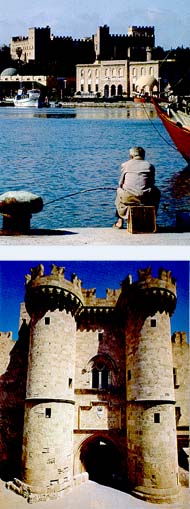 Important churches include that of the Virgin (15th
century), St. Panteleimon and the
ruined church of the Virgin of Victory, built after the
successful repulsion of the
besieging Turks in 1480. Close by is St. Catherine's
Gate leading also to the Harbor Gate
and St. Paul's Gate. The town is girt by a wall 4 km. in
perimeter and at set times there
are organized walks upon it, a truly memorable
experience. These ramparts were built in the
14th century, replacing an earlier Byzantine enceinte. A
large number of Early Christian
churches have survived in Rhodes, including the
outstanding 5th century basilica (at the
intersection of P. Melas and Cheimaras Streets). Other
significant churches are the Virgin
of the Castle (11th - 12th century), S. Phanourios (for
some time the mosque Plial Din)
which is of 13th century date and h important
wall-paintings and St. George, which has 14th
- 15th century wall-paintings. The ancient city of
Rhodes, founded in 401 BC extended
northwards and eastwards of the acropolis (Monte Smith)
and the medieval town of the
Knights stands on top of a greater part of it. The
summit of Monte Smith, from where there
is a magnificent view over verdant land and azure sea,
was the ancient acropolis. Remnants
of the temples of Athena Polias and Zeus Polieus are
preserved and, to the west, the temple
of Apollo. Restored and ruined edifices can still be
seen, including the theater and
stadium (2nd century BC), both restored by the Italians,
and the gymnasium. The new town is
also an interesting place with its numerous Italian
colonial style buildings and many
churches. There is also a Municipal Art Gallery, Islamic
Library and rich Folk Art
collection.
A visit to the island's interior is an unforgettable
experience on account of the wonderful
scenery and abundance of monuments in every village and
hamlet.
15 km. southwest of the town of Rhodes, near the village
of Trianda, on top of mount
Philerimos is the ancient site of lalysos, one of the
island's three Dorian cities. The
foundations of the temple of Athena and Zeus Polieus are
preserved (4th century BC), as
well as remnants of Byzantine and medieval buildings.
Here too is the important church of
the Virgin of Philerimos which belonged to a 15th
century monastery built by the Knights of
St. John. Yet another significant church is that of Ai
Yorgi tou Chostou in which there are
14th and 15th century wall-paintings. There is also a
well-preserved 4th century BC Doric
fountain and a 134-stepped Way to Golgotha with mosaic
plaques of the Twelve--Stations of
the Cross along its right side. The Valley of the
Butterflies (20 km. south of Rhodes) is a
densely wooded region which attracts myriads of brightly
colored butterflies between June
and September and is a popular tourist haunt. Important churches include that of the Virgin (15th
century), St. Panteleimon and the
ruined church of the Virgin of Victory, built after the
successful repulsion of the
besieging Turks in 1480. Close by is St. Catherine's
Gate leading also to the Harbor Gate
and St. Paul's Gate. The town is girt by a wall 4 km. in
perimeter and at set times there
are organized walks upon it, a truly memorable
experience. These ramparts were built in the
14th century, replacing an earlier Byzantine enceinte. A
large number of Early Christian
churches have survived in Rhodes, including the
outstanding 5th century basilica (at the
intersection of P. Melas and Cheimaras Streets). Other
significant churches are the Virgin
of the Castle (11th - 12th century), S. Phanourios (for
some time the mosque Plial Din)
which is of 13th century date and h important
wall-paintings and St. George, which has 14th
- 15th century wall-paintings. The ancient city of
Rhodes, founded in 401 BC extended
northwards and eastwards of the acropolis (Monte Smith)
and the medieval town of the
Knights stands on top of a greater part of it. The
summit of Monte Smith, from where there
is a magnificent view over verdant land and azure sea,
was the ancient acropolis. Remnants
of the temples of Athena Polias and Zeus Polieus are
preserved and, to the west, the temple
of Apollo. Restored and ruined edifices can still be
seen, including the theater and
stadium (2nd century BC), both restored by the Italians,
and the gymnasium. The new town is
also an interesting place with its numerous Italian
colonial style buildings and many
churches. There is also a Municipal Art Gallery, Islamic
Library and rich Folk Art
collection.
A visit to the island's interior is an unforgettable
experience on account of the wonderful
scenery and abundance of monuments in every village and
hamlet.
15 km. southwest of the town of Rhodes, near the village
of Trianda, on top of mount
Philerimos is the ancient site of lalysos, one of the
island's three Dorian cities. The
foundations of the temple of Athena and Zeus Polieus are
preserved (4th century BC), as
well as remnants of Byzantine and medieval buildings.
Here too is the important church of
the Virgin of Philerimos which belonged to a 15th
century monastery built by the Knights of
St. John. Yet another significant church is that of Ai
Yorgi tou Chostou in which there are
14th and 15th century wall-paintings. There is also a
well-preserved 4th century BC Doric
fountain and a 134-stepped Way to Golgotha with mosaic
plaques of the Twelve--Stations of
the Cross along its right side. The Valley of the
Butterflies (20 km. south of Rhodes) is a
densely wooded region which attracts myriads of brightly
colored butterflies between June
and September and is a popular tourist haunt.
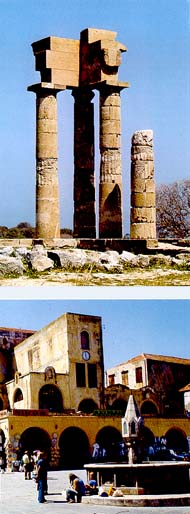 Another of the major archaeological sites on Rhodes is Kameiros, one of the three Dorian
cities. Built in a valley it has neither a city wall nor
an acropolis and its houses and
temples were revealed in excavations conducted by the
Italians. The restored columns of a
Hellenistic house are particularly impressive, as is the
Doric stoa in the agora and part
of the temple of Athena. South of Kameiros is Kastello,
a castle built by the knights on
the pinnacle of an imposing crag. At Embonas (13 km.
southeast), one of the quaintest
villages on Rhodes with lovely traditional houses, local
customs are still very much alive
and many villagers still wear Rhodian costume. The most
impressive fortress is that of
Monolithos (92 km. southwest of Rhodes). This is an
inland village on the south side of the
island, far off the tourist track and rather difficult
to get to. The knights built the
castle in the 15th century at the very top of a
precipitous cliff beside the sea, from
where one has an unrivalled view. Other interesting
villages on the south coast are
Mesanagros (106 km. from Rhodes) and Kattavia, famed for
its woven goods. The now-ruined Skiadi monastery merits a visit to see the important
wall-paintings in its katholikon and
the Ypseni monastery near Lardos is also of interest.
Archangelos is a particularly pretty
village (south of Rhodes) with dazzling white houses,
and then there is Malonas from where
one can visit the castle of Faraklos, one of the largest
and mightiest on Rhodes. Further
south (58 km. from Rhodes) is Lindos, perhaps the most
beautiful village on the island,
with its narrow streets and fascinating houses in which
the traditional interior decoration
is still kept with copious wood-carving and the famous
"Lindian" plates. An inscription
bearing the date 1489/90 is preserved in the parish
church and the coat-of-arms of Grand
Master d'Aubusson. The village is dominated by the
ancient acropolis built at the edge of a
steep rock. Remnants of the sanctuary and temple of
Athena Lindia (4th century BC) have
been uncovered and partially restored, as also the Stoa
and Propylaia. There are also
traces of the temple of Dionysos and, on the west slope;
the ancient theatre is preserved
in quite good condition. Graves have also been brought
to light in the area, including that
popularly known as The Tomb of Kleoboulos. Just inside
the entrance to the acropolis is the
ruined castle of the knights and Byzantine church of St.
John. At the base of the large
stairway leading up to the acropolis there is a large
Hellenistic relief of a trireme
carved in the rock and to the right of it steps of the
ancient flight of stairs are
preserved. Another of the major archaeological sites on Rhodes is Kameiros, one of the three Dorian
cities. Built in a valley it has neither a city wall nor
an acropolis and its houses and
temples were revealed in excavations conducted by the
Italians. The restored columns of a
Hellenistic house are particularly impressive, as is the
Doric stoa in the agora and part
of the temple of Athena. South of Kameiros is Kastello,
a castle built by the knights on
the pinnacle of an imposing crag. At Embonas (13 km.
southeast), one of the quaintest
villages on Rhodes with lovely traditional houses, local
customs are still very much alive
and many villagers still wear Rhodian costume. The most
impressive fortress is that of
Monolithos (92 km. southwest of Rhodes). This is an
inland village on the south side of the
island, far off the tourist track and rather difficult
to get to. The knights built the
castle in the 15th century at the very top of a
precipitous cliff beside the sea, from
where one has an unrivalled view. Other interesting
villages on the south coast are
Mesanagros (106 km. from Rhodes) and Kattavia, famed for
its woven goods. The now-ruined Skiadi monastery merits a visit to see the important
wall-paintings in its katholikon and
the Ypseni monastery near Lardos is also of interest.
Archangelos is a particularly pretty
village (south of Rhodes) with dazzling white houses,
and then there is Malonas from where
one can visit the castle of Faraklos, one of the largest
and mightiest on Rhodes. Further
south (58 km. from Rhodes) is Lindos, perhaps the most
beautiful village on the island,
with its narrow streets and fascinating houses in which
the traditional interior decoration
is still kept with copious wood-carving and the famous
"Lindian" plates. An inscription
bearing the date 1489/90 is preserved in the parish
church and the coat-of-arms of Grand
Master d'Aubusson. The village is dominated by the
ancient acropolis built at the edge of a
steep rock. Remnants of the sanctuary and temple of
Athena Lindia (4th century BC) have
been uncovered and partially restored, as also the Stoa
and Propylaia. There are also
traces of the temple of Dionysos and, on the west slope;
the ancient theatre is preserved
in quite good condition. Graves have also been brought
to light in the area, including that
popularly known as The Tomb of Kleoboulos. Just inside
the entrance to the acropolis is the
ruined castle of the knights and Byzantine church of St.
John. At the base of the large
stairway leading up to the acropolis there is a large
Hellenistic relief of a trireme
carved in the rock and to the right of it steps of the
ancient flight of stairs are
preserved.
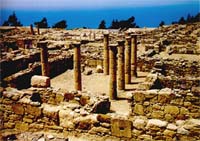 At Thermes Kallithea (10 km. southeast of Rhodes) there
are therapeutic springs. Kallithea
is a particularly attractive region on the coast, very
richly vegetated. Afanto is yet
another delightful village (20 km. south of Rhodes)
which developed in the days of the
corsairs and was so named because it was not visible
from the sea. There is a golf course
nearby. Villages in which the vernacular heritage of
Rhodes is still much in evidence
include Koskinou (8 km. southeast of Rhodes) where the
house interiors are decorated with
Rhodian ceramics and woven items. Kremas (12 km.
southeast of Rhodes) is a tourist village,
surpassed by Faliraki (14 km. southeast of Rhodes) which
is even more cosmopolitan. Other
places worth visiting are Asklipeio, and the church of
Aghios Nikolaos at Fountoukli.
Beaches and stretches of coast suitable for swimming and
sea sports abound on Rhodes.
Within the main town the beach between the yacht club
and Hotel Mediterranean is fully
equipped for all manner of sea sports. The beaches at
Kanaris quay, Faliraki and Lindo are
lovely and the bays at Kremasti and Kameiros large. The
eastern shores are more sheltered.
There are stretches of sand at Afantou, Koskinou and the
entire strip of coast a far as
Lindos and Prasonisi. At Thermes Kallithea (10 km. southeast of Rhodes) there
are therapeutic springs. Kallithea
is a particularly attractive region on the coast, very
richly vegetated. Afanto is yet
another delightful village (20 km. south of Rhodes)
which developed in the days of the
corsairs and was so named because it was not visible
from the sea. There is a golf course
nearby. Villages in which the vernacular heritage of
Rhodes is still much in evidence
include Koskinou (8 km. southeast of Rhodes) where the
house interiors are decorated with
Rhodian ceramics and woven items. Kremas (12 km.
southeast of Rhodes) is a tourist village,
surpassed by Faliraki (14 km. southeast of Rhodes) which
is even more cosmopolitan. Other
places worth visiting are Asklipeio, and the church of
Aghios Nikolaos at Fountoukli.
Beaches and stretches of coast suitable for swimming and
sea sports abound on Rhodes.
Within the main town the beach between the yacht club
and Hotel Mediterranean is fully
equipped for all manner of sea sports. The beaches at
Kanaris quay, Faliraki and Lindo are
lovely and the bays at Kremasti and Kameiros large. The
eastern shores are more sheltered.
There are stretches of sand at Afantou, Koskinou and the
entire strip of coast a far as
Lindos and Prasonisi.
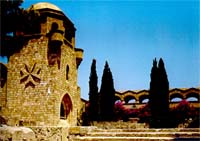 There is an athletics stadium,
riding club, volley court, tennis
courts, golf course, and two water skiing schools on
Rhodes. Fishing is particularly good
at Kallithea, Kameiros, Lindos and Vlychoi bay. In the
mountains of the hinterland and the
Lindos area one can shoot small game and birds. There
are scores of hotels of all
categories, as well as pensions, rooms and apartments to
let. The visitor is assured an
enjoyable and comfortable stay. Those with a private
yacht or boat can refuel at the harbor
and at Mandraki boats can also be hired for those
wishing to make excursions to nearby
islands. There is an athletics stadium,
riding club, volley court, tennis
courts, golf course, and two water skiing schools on
Rhodes. Fishing is particularly good
at Kallithea, Kameiros, Lindos and Vlychoi bay. In the
mountains of the hinterland and the
Lindos area one can shoot small game and birds. There
are scores of hotels of all
categories, as well as pensions, rooms and apartments to
let. The visitor is assured an
enjoyable and comfortable stay. Those with a private
yacht or boat can refuel at the harbor
and at Mandraki boats can also be hired for those
wishing to make excursions to nearby
islands.
|

